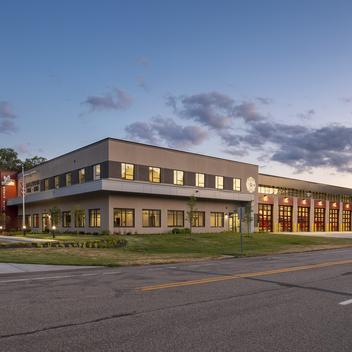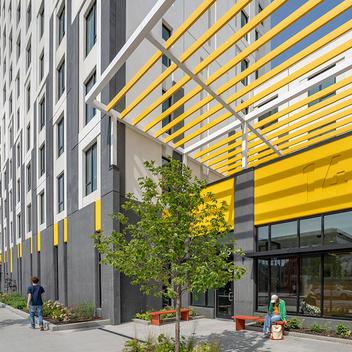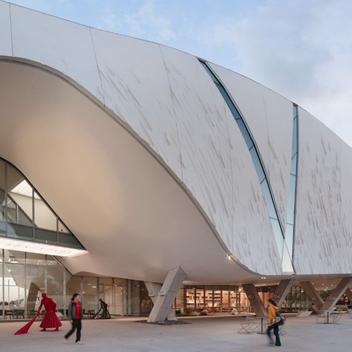This article was originally published in School Construction News May/June 2025 issue.
As resilient design takes center stage, the demand for life-safety structures is reshaping how public buildings are planned, especially in regions vulnerable to high-wind events. Architects and engineers are increasingly tasked with integrating safe spaces into everyday environments, balancing code requirements, funding opportunities, and functional design. The issue hasn’t gone unnoticed by the K-12 educational community.
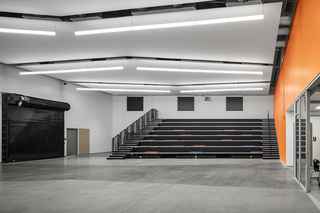
Valley Southwoods Freshman High School, West Des Moines, IA
Across the U.S., more K-12 schools are incorporating storm shelters into their designs. Wells alone has built more than 50 storm shelters throughout the Midwest in the last four years. In addition to meeting 2018 IBC building code requirements, schools are also addressing concerns of student and staff safety, with the growing frequency and severity of extreme weather events like tornadoes and hurricanes.
The growing threat of tornadoes and hurricanes.
Each year, hundreds of tornadoes and severe storms impact the central and southeastern regions of the country, threatening communities and the infrastructure that supports them. Schools play an important role in supporting the community; many are particularly vulnerable, operating in older buildings without adequate protection.
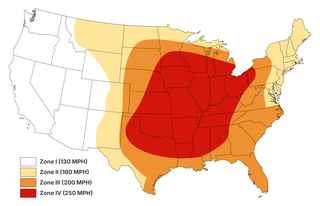
A large area of growing concern is the central part of the country—often referred to as “Tornado Alley”—where high wind events pose a serious risk.
Quick Facts:
- The U.S. experiences over 1,200 tornadoes each year, which is more than any other country in the world (Source: US National Science Foundation)
- There is a significant upward trend in tornado frequency in portions of the Southeast, Midwest, and Northeast of the U.S. since 1979 (Source: npj Climate and Atmospheric Science)
- Hurricanes are becoming stronger and more destructive, with the most damaging U.S. hurricanes being three times more frequent than 100 years ago (Source: Environmental Defense Fund)
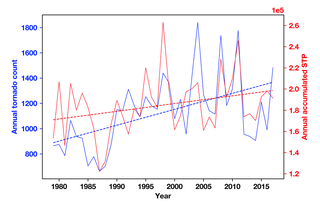
There is a significant upward trend in tornado frequency in portions of the Southeast, Midwest, and Northeast portions of the U.S. since 1979 (Source: npj Climate & Atmospheric Science)
These realities are prompting a shift: more districts are investing in storm shelter spaces that can protect students, staff, and the community when disaster strikes.
What’s driving the trend towards more storm shelters?
The increase in storm shelters in K12 schools isn’t coincidental. It’s the result of evolving building codes, expanded funding opportunities, growing climate concerns, and a stronger commitment to occupant safety from both public and private stakeholders.
Updated Building Codes
With the advent of the 2018 IBC Code Requirements for ICC 500 Storm Shelters, all Group E occupancies in designated risk areas with an occupant load of 50 or more are expected to have an extreme-wind storm shelter that can withstand winds speeds of 250 mph.
Federal and State Funding Initiatives
At the same time, funding mechanisms have expanded to support resilient infrastructure. Programs like FEMA’s Hazard Mitigation Grant Program (HMGP), Pre-Disaster Mitigation (PDM), and the newer Building Resilient Infrastructure and Communities (BRIC) initiative offer critical financial support for school districts looking to offset the cost of storm shelter construction. These grants have made it possible for many communities—especially in rural or lower-income districts—to implement safety measures that may otherwise have been financially out of reach.
Climate Awareness and Risk Assessment
The increasing frequency, intensity, and unpredictability of severe weather events has raised public and professional awareness. Tornadoes in non-traditional areas, shifting hurricane paths, and longer storm seasons are pushing school districts and other public support entities (like Baptist Hospital in Pensacola, FL) to rethink how buildings are designed and used in emergencies. What was once considered an isolated risk has now become part of long-term planning for educational and civic infrastructure.
Community Dual-Use Planning
More jurisdictions are creating storm shelters as multi-functional community assets. These spaces—often gymnasiums, cafeterias, or auditoriums—are designed to serve both day-to-day educational needs and emergency preparedness functions. When designed properly, they meet life-safety standards without compromising programmatic space or aesthetics.
Prefabricated Concrete Storm Shelters
There’s a clear rise in the number of K12 projects requesting storm shelters across the central and southeastern U.S., and for many school districts, prefabricated concrete has become the most practical solution for creating a building that lasts.
Even before the 2018 IBC code implementation, prefabricated components were a material of choice for school systems in more northerly climates. In Minnesota, for example, precast has been a popular building material in educational settings for nearly 30 years. Voter referendums are typically passed in November, giving contractors a short 19-month window to complete the project, sometimes less.
Precast enables them to work through the winter season, since manufacturing occurs indoors, and installation can take place in any weather. The same can’t be said for cast-in-place, brick, and block, as wrapping and heating the worksite, often necessary in colder climates, is cost-prohibitive.
In part due to the ICC code, precast is now making significant inroads into other regions that have historically relied on other building materials. Schools such as Roosevelt Elementary School in Hays, Kans.; Maple River K12 in Mapleton, Minn.; Life School in Carrollton, Tex.; and Valley Southwoods Freshman High School in West Des Moines, Iowa, all chose a total precast solution for their storm shelters in a departure from more traditional materials.
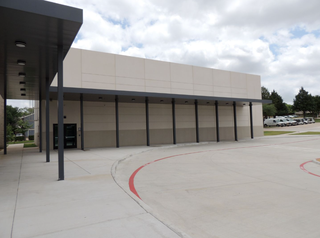
Life School, Carrollton, TX
What did they get in return? In short, a stronger and more durable, sustainable concrete roof and wall system that offers wind and fire resistance, superior thermal performance, design flexibility and greater control over the schedule.
Standard prefabricated concrete safe rooms can easily and economically be designed to exceed the 250-mph wind speed requirement. The standard panel already comes close to the ICC storm shelter code, as they’re typically designed to a 7,000-psi standard, which can exceed 10,000 psi after curing. To comply with the ICC code, we increase the size of our insulated panels from 12 inches thick to 14 inches thick—all prestressed with vertical strands to compress the panel. NOTE: Variations in the design might be necessary when windows are present, as the glass transfers additional wind load into the precast. Along with prefabricated wall panels, Wells can manufacture Double Tee roof panels with up to a 100-foot spans for a high school gymnasium.
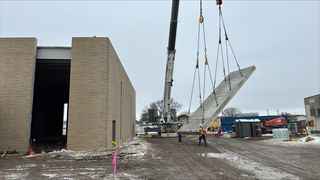
Roosevelt Elementary School, Hayes, KS
Usually, the gymnasium is designated as a school’s storm shelter. While it may seem counterintuitive to design such a large space to storm shelter requirements, the reasons are grounded in the ICC code itself. Beyond the obvious fact that gymnasiums can hold more people and are easily identifiable, a storm shelter must be capable of taking the collapsed load of any taller structure nearby. Smaller spaces can be more difficult to design to the ICC standard, making them less feasible.
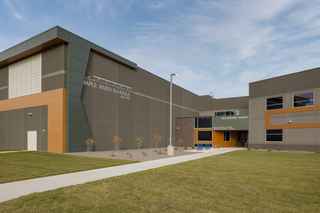
Maple River K12 School, Mapleton, MN
As weather events become more frequent and severe, school districts are responding by investing in resilient infrastructure. The rise of storm shelters—particularly those built with prefabricated concrete—is a trend rooted in safety, durability, and smart design. Ultimately, they’re successfully achieving the dual goals of protecting their students and responsibly managing public funds.
About the Author

Gary is a Regional Sales Manager for Wells and has been in the precast industry for nearly four decades. With a wealth of experience, including thousands of projects, he brings a unique and valuable perspective to the industry with inventive solutions for finish designs. Gary is actively engaged in various construction organizations, currently serving as a board member of Minnesota Prestress Association.

